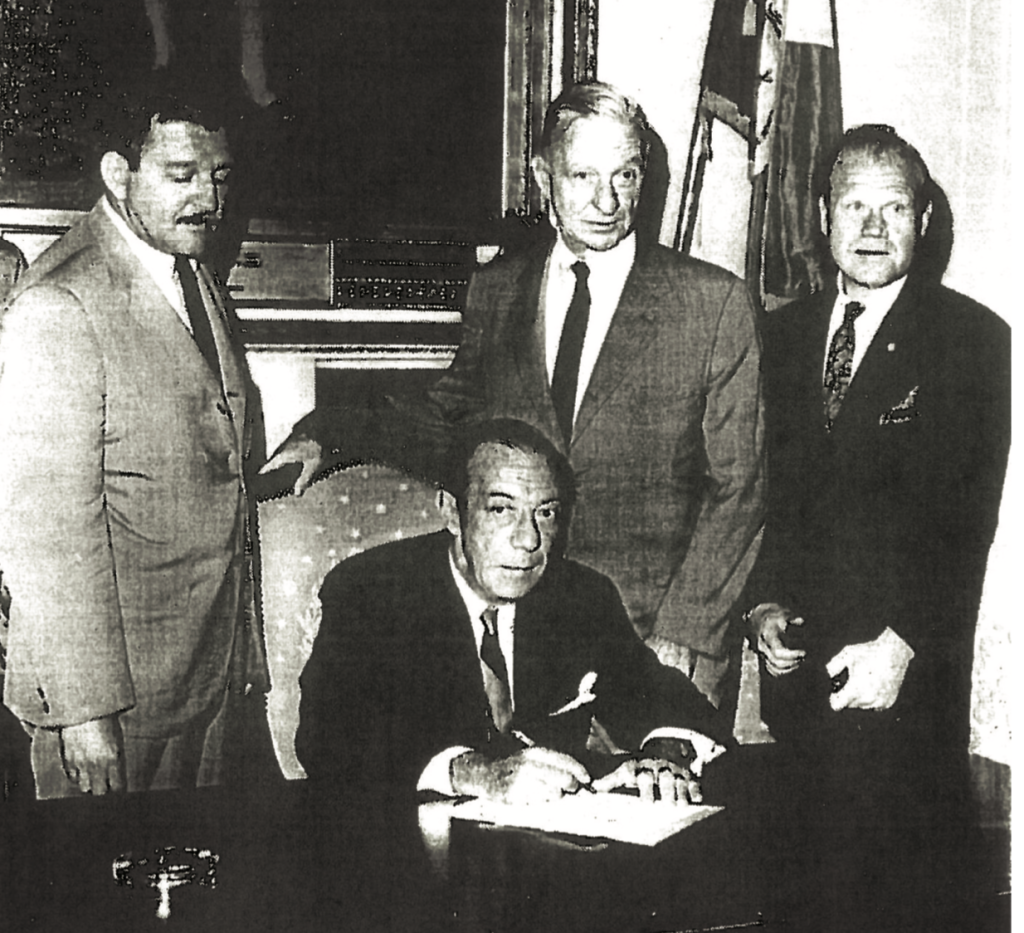Geoffrey Platt
January 16, 2020 | Anthony C. Wood
The Man on the High Wire
Needing to refresh my memory on how many historic districts had been proposed and how many designated during the tenure of the first Chair of the Landmarks Preservation Commission (LPC), Geoffrey Platt, I turned to the “Preservation by the Numbers” article in the Fall/Winter 2018 issue of this publication. I was mortified to discover that in our apparent haste to provide information on the designation records of all the LPC Chairs, we had committed a sin of omission: Chairman Platt’s numbers were not included in the article. To remedy that, here they are: during Platt’s tenure as chair of the LPC (1965-1968), the Commission proposed 23 historic districts, including eight outside Manhattan, and designated six. His legacy includes the first district, Brooklyn Heights, as well as Gramercy Park and Hunters Point. Not that there is a contest, but that puts Platt in second place, with the highest number of proposed districts during the tenure of any LPC chair belonging to Robert Tierney with 47.
Regrettable as the omission of Platt may be, correcting it creates an opportunity to share with newer generations of preservationists the landmark legacy of Geoffrey Platt. Platt’s contributions to preservation started well before he became Chair of the LPC. In many ways, he was the midwife of the Landmarks Law. In 1961, he and Harmon Goldstone (both in leadership positions at the Municipal Art Society at the time), guided and supported by James Felt, the Chair of the City Planning Commission, succeeded in having Mayor Wagner appoint “The Mayor’s Committee for the Preservation of Structures of Historic and Esthetic Importance.” Platt then chaired that committee, which recommended the creation of an Advisory Landmarks Preservation Commission. Mayor Wagner implemented that suggestion by creating the Commission on April 21, 1962 and named Platt as its Chair. Over the next four years, the Advisory Landmarks Preservation Commission (Advisory LPC), under Platt’s leadership, would begin to identify and designate landmarks (without any power to protect them) and draft a proposed landmarks law. Ultimately, highly public preservation controversies would propel that draft legislation forward. After hearings, debate, modifications, and more preservation dramas, it would be signed into law by Mayor Wagner on April 19, 1965.

These basic facts fail to do justice to Platt’s enormous contribution to preservation. The skill, diplomacy, patience, and perseverance required to navigate the shark-infested waters of New York City politics at that moment in time (and perhaps at any moment in time) cannot be underestimated. The Advisory LPC was cautious, and largely side-stepped the Pennsylvania Station controversy. Other landmark-worthy sites would also be lost as the work slowly moved forward. Platt was criticized for this, but his singular goal was achieving the passage of a landmarks law with true regulatory power.
Platt’s public policy high-wire act didn’t stop with the passage of the Law. Over the next three years, Platt shepherded an unproven city agency as it implemented an untested law in a hostile environment. At the signing of the law, Mayor Wagner stated that if the law was found to be “too restrictive on property rights or did not meet the problems of landmark owners,” it would be amended. On one side, Platt was confronted with preservation advocates who had been fighting for decades to obtain a law. There was huge unmet demand for action to preserve numerous threatened sites and historic neighborhoods. On the other side, if the Commission went too far too fast, Platt confronted the very real possibility of lawsuits and a political backlash from the real estate community that could have led to the weakening or even eradication of the law. During this period of uncertainty, his guiding principle was to do nothing that would jeopardize the Landmarks Law itself.
Platt, guided by that philosophy, would receive criticism from preservation advocates demanding more decisive action by the LPC while he simultaneously dodged threats of lawsuits from those working to undermine the law. Was he too conservative? Did he strike the right balance? Almost enough time has passed for historians to weigh in on that question. However, that creative tension between advocates for the aggressive application of the Landmarks Law and those conservatively administering that law continues to this day. Knowing preservation’s history can provide context for that ongoing dynamic.
Geoffrey Platt’s full preservation legacy deserves its own monograph. While waiting for someone to write it, you can find on the Archive Project’s website, under “Our Collections: Oral histories,” an interview with Geoffrey Platt conducted in 1984 and originally published in Village Views, volume 4, Number 1. More on Platt can be found in Gregory Gilmartin’s Shaping the City: New York and the Municipal Art Society, Marjorie Pearson’s New York Landmarks Preservation Commission (1962-1999): Paradigm for Changing Attitudes Towards Historic Preservation and this author’s Preserving New York: Winning the Right to Protect a City’s Landmarks. References to Platt also appear in numerous oral histories on the Archive Project website. So, was Platt too conservative a preservationist or as much a preservationist as his times allowed? Start reading preservation history and you may reach your own conclusion.